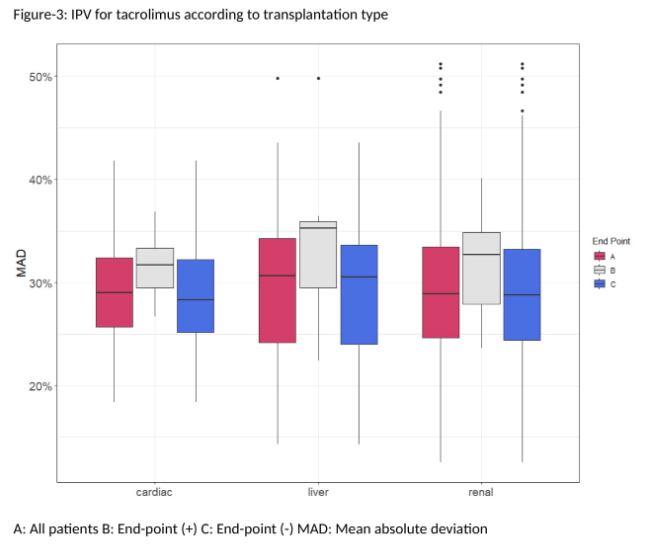Analysis of intra-patient variability of tacrolimus in transplant patients with data mining
Deniz Ilhan Topcu1, Didem Turgut2, Zeynep Kendi Celebi2, Mehmet A. Haberal3.
1Medical Biochemistry, Baskent University, Ankara, Turkey; 2Nephrology, Baskent University, Ankara, Turkey; 3Transplantation, Baskent University, Ankara, Turkey
Introduction: Objective usage of tacrolimus in transplant setting is complicated by its narrow therapeutic index and wide intra-patient pharmacokinetic variability. Intra-patient variability (IPV) for tacrolimus was claimed to be a predictor of inferior outcomes in transplantation (Tx). The aim of this study is to investigate IPV of tacrolimus retrospectively with data mining and to discover if IVP patterns differ in solid organ transplant patients. The data mining approaches facilitates analysis of retrospective electronic medical records (EHR).
Material and Method: We analyzed patients who had cardiac, liver or renal tx between 2011 and 2019 in Başkent University Ankara Hospital. Adult patients after six month of transplantation were included in the study. All data were obtained from hospital and laboratory recording system. IPV was calculated as mean absolute deviation (MAD). IPV results compared among cardiac, liver and renal transplant patients and their end-point status. End-point status was accepted as mortality in cardiac and liver tx patients; and end-stage renal disease (ESRD) in renal tx patients. Initial number of patients was 1210 and tacrolimus records were 36,789. 12,746 tacrolimus results belong to 499 patients were transformed into IPV according to inclusion criteria at the end of data processing (Figure-1). Additionally, correlation between serum creatinine levels and IVP were assessed. R 3.6.2 (R Working Group, Vienna, Austria) was used for data mining and statistical analyses.
Results: Tacrolimus blood levels and IVP results due to transplantation type and end-point (mortality or ESRD) are summarized in Table-1. Tacrolimus blood levels were highest in cardiac tx group (p<0.001) (Figure-2). IPV results were higher in liver tx group in respect to cardiac and renal tx groups, but the difference was not statistically significant. IPV results of cardiac tx patients with mortality (p=0.085), liver tx patients with mortality (p=0.19) and renal tx patients with ESRD (p=0.04) were higher in all three groups in respect to patients without end-point condition. But only renal tx group was statistically different (Figure-3). There was no correlation between IPV and serum creatinine levels in all groups.
Conclusion: IPV of tacrolimus results are similar in different types of solid organ transplantation. But IPV results were higher in patients with inferior outcomes in all transplantation types. Although end-point differences need more clinical judgement, high variability for tacrolimus in this group is obvious. Data mining is an important way to analyze such big data related to transplantation setting and should be used more commonly with more clinical data.




There are no comments yet...